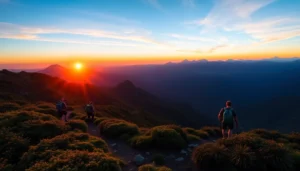
Introduction to Hiking in Lombok
Hiking has become one of the most popular outdoor activities worldwide, and Indonesia’s Lombok Island stands out as a premier destination for enthusiasts seeking adventure, natural beauty, and cultural immersion. Known for its breathtaking landscapes, rugged terrains, and serene waterfalls, Lombok offers a diverse array of hiking experiences suitable for both beginners and seasoned trekkers. If you’re looking to explore the island’s pristine wilderness, anticipate unforgettable adventures, and connect deeply with nature, understanding the essentials of hiking in Lombok is crucial. Whether you’re captivated by the challenge of Mount Rinjani or excited to discover hidden rainforest trails, Lombok’s hiking opportunities promise both thrill and tranquility, making it an ideal tropical escape for outdoor lovers. For those new to outdoor pursuits, exploring hiking in Lombok could be your next life-changing experience.
What Makes Lombok a Prime Hiking Destination
Lombok, often overshadowed by its neighbor Bali, silently boasts some of Southeast Asia’s most stunning and diverse hiking terrains. This island’s appeal lies in its versatility—ranging from volcanic summits and lush rainforests to coastal pathways and traditional villages—that draws eco-tourists, adventure seekers, and cultural explorers alike.
First and foremost, Mount Rinjani, Indonesia’s second-highest volcano, stands as the crown jewel for hikers. Its summit, Tambora, provides panoramic views of the surrounding islands and the Caldera Lake, Segara Anak. The ascent typically takes 2-3 days, demanding physical stamina but rewarding hikers with extraordinary vistas and a sense of achievement. The trail to Rinjani’s summit is considered challenging but manageable with proper preparation, making it ideal for moderate to advanced trekkers.
Beyond Rinjani, Lombok’s coastal trails, such as those leading to beautiful beaches like Selong Belanak or hidden coves, allow hikers to experience pristine ocean vistas and sandy shores. Meanwhile, the island’s rainforests and waterfalls—like Sendang Gile and Tiu Kelep—offer invigorating day trips for nature lovers seeking tranquility and scenic beauty.
What truly cements Lombok as a prime hiking destination is its blend of natural splendors with authentic local culture. Traversing rural villages enables trekkers to witness traditional Sasak life, taste local delicacies, and understand the island’s distinct heritage—a multisensory journey that enhances any outdoor adventure.
Historical and Cultural Highlights Along Trails
While Lombok’s natural landscapes are captivating, their historical and cultural significance enrich the hiking experience. Many trails pass through ancient sites, traditional villages, and religious landmarks that reveal the island’s deep-rooted cultural tapestry.
One notable example is the *Sasak villages* along the foothills of Rinjani. These communities retain centuries-old customs, weaving, and architecture, giving visitors insight into traditional life. Engaging with locals during hikes fosters cultural exchange and appreciation, transforming outdoor activity into a meaningful exploration of Lombok’s heritage.
Furthermore, several trails are intertwined with historical stories—such as the volcanic eruptions of Mount Rinjani—impacting local settlements and shaping the island’s history. The remnants of ancient lava flows and volcanic craters serve as natural monuments that connect hikers to Lombok’s geological past.
Religious sites like Hindu temples and mosques along popular routes offer serene stops for reflection and cultural immersion, providing spiritual insights alongside physical activity. Incorporating these points of interest into your hike makes it not just an outdoor adventure but also a journey through Lombok’s collective identity.
Preparing for Your Hiking Adventure in Lombok
Physical Preparation and Fitness
Hiking in Lombok, especially routes like Mount Rinjani, demands physical endurance. Prior to your trip, engage in cardio exercises such as running, cycling, or swimming to build stamina. Strength training focusing on legs, core, and endurance will also enhance your capability to handle challenging terrains. Preparing your body weeks in advance minimizes risks of injury and ensures a more enjoyable experience.
Gear and Equipment Recommendations
Proper gear significantly impacts safety and comfort. Invest in a sturdy, comfortable hiking boot with good ankle support and grip. Layered clothing suitable for variable weather—such as moisture-wicking shirts, lightweight waterproof jackets, and thermal layers—is essential. Carry a lightweight backpack with essentials: water bottles, high-energy snacks, a first aid kit, sun protection (sunscreen, hat, sunglasses), navigation tools (maps, GPS), and a headlamp or flashlight for early morning or evening hikes.
Health and Safety Tips
Hydration and nutrition are vital. Drink plenty of water to prevent dehydration, especially in a tropical climate. Be mindful of altitude sickness when ascending Rinjani; ascend gradually and acclimate if possible. Always inform someone about your route and expected return time. Consider hiring local guides for unfamiliar trails—they bring valuable knowledge about terrain, weather, and cultural sites, enhancing both safety and quality of your experience.
Environmental Responsibility and Leave No Trace
Respect the natural environment by adhering to the Leave No Trace principles. Pack out all trash, avoid disturbing wildlife, stay on designated trails, and minimize campfire impact. Supporting local communities by purchasing regional products and services also promotes sustainable tourism and helps preserve Lombok’s natural beauty for future generations.
Top Hiking Trails in Lombok
Mount Rinjani Trekking Routes
Mount Rinjani offers several trekking routes, each with distinct features and challenges:
- Senaru Route: The most popular and accessible route, starting from Senaru village, suitable for beginners and intermediate hikers. It typically takes 2-3 days to reach the crater rim, with sights of waterfalls and lush forests along the way.
- Sembalun Route: Starting from Sembalun Lawang, this path is flatter initially but becomes more demanding as you ascend toward the summit. It’s favored for aspiring climbers aiming for a spectacular sunrise from Rinjani’s peak.
- South Side Trek: A less crowded trail that offers unique perspectives and a more rugged, untouched environment—ideal for experienced adventurers seeking solitude.
Coastal and Rainforest Trails
Lombok’s coastal paths provide accessible day hikes, connecting secluded beaches and waterfalls. Notable trails include:
- Segara Anak Lake Trails: Hike to the crater lake for stunning views and peaceful surroundings.
- Sendang Gile and Tiu Kelep Waterfalls: Easy day trips through forested pathways leading to cascading waterfalls perfect for swimming and relaxation.
- Pusuk Monkey Forest Trail: A trail through lush greenery inhabited by the playful gray monkeys, offering close encounters with nature and wildlife.
Hidden Trails and Off-the-Beaten-Path Adventures
Beyond the well-known trails, Lombok hosts numerous lesser-known paths that reward explorers with untouched scenery:
- Kuta Belong Village: Trek through rice terraces and traditional villages en route to pristine beaches.
- Mount Tukar in Sembalun: An easier summit with panoramic views of Rinjani and the surrounding islands.
- Saput River Trek: Explore remote rainforest pathways and river crossings for a secluded adventure.
Essential Tips for a Safe and Enjoyable Hike
Gear and Equipment Recommendations
Equipping yourself correctly is the first step toward a successful hike. Use high-quality hiking boots to prevent blisters and injuries. Carry layered clothing to adapt to changing weather conditions, and always pack essentials like navigation tools, a first aid kit, sun protection, and sufficient water. For longer expeditions, lightweight camping gear and cooking supplies might be necessary.
Best Practices for Trail Safety
Stay on designated trails to prevent environmental impact and avoid getting lost. Check weather forecasts before heading out, and plan your pace according to your fitness level. Use GPS devices or mobile apps for navigation, but always have a physical map as a backup. Inform someone about your itinerary, especially when exploring remote areas. Consider hiring local guides for unfamiliar or challenging routes to enhance safety and gain local insights.
Environmental Responsibility and Leave No Trace
Protect Lombok’s natural beauty by following Leave No Trace principles. Carry all waste out with you, avoid picking plants or disturbing wildlife, and minimize campfire impact by using existing fire rings or portable stoves. Respect local cultures and traditions, and engage with communities in a respectful and responsible manner to promote sustainable tourism.
Health Benefits of Hiking in Lombok
Physical Fitness and Endurance Building
Regular hiking, especially on Lombok’s diverse terrain, offers comprehensive cardiovascular and muscular benefits. It enhances stamina, promotes weight management, and boosts overall physical health. The varied altitudes and terrains challenge different muscle groups, leading to improved strength and flexibility.
Mental Clarity and Stress Relief
Being immersed in nature helps reduce stress, anxiety, and mental fatigue. The natural serenity, fresh air, and scenic views stimulate the release of endorphins, enhancing mood and mental clarity. Scientific studies underscore outdoor activity’s positive impact on mental health, making Lombok’s trails perfect natural therapy.
Connecting with Nature and Local Culture
Hiking in Lombok creates opportunities for meaningful cultural exchanges and environmental awareness. Interacting with local communities and experiencing traditional lifestyles fosters a sense of connection and respect for sustainable living practices. This holistic approach to outdoor activity amplifies its health and wellness benefits.
Planning Your Hiking Trip
Best Seasons and Weather Considerations
Lombok’s dry season, from April to October, is optimal for hiking. During this period, weather is generally clear, temperatures are moderate, and trails are less muddy, enhancing safety and comfort. The wet season (November to March) brings frequent rains, slippery terrains, and higher risks of landslides, which may restrict access to certain routes.
Guided vs. Independent Hiking
While independent hiking offers flexibility and affordability, guided tours provide safety, local expertise, and cultural insights—especially on challenging routes like Rinjani. Guided companies often include logistics, permits, and safety equipment, removing many logistical barriers and increasing safety for less experienced hikers.
Local Resources and Guided Tours
Lombok features numerous local operators offering guided hikes, equipment rentals, and logistical support. Engaging with licensed providers ensures adherence to safety standards, respect for local communities, and support for sustainable tourism. Prior research and reviews can help select reputable guides for an enriching experience.



